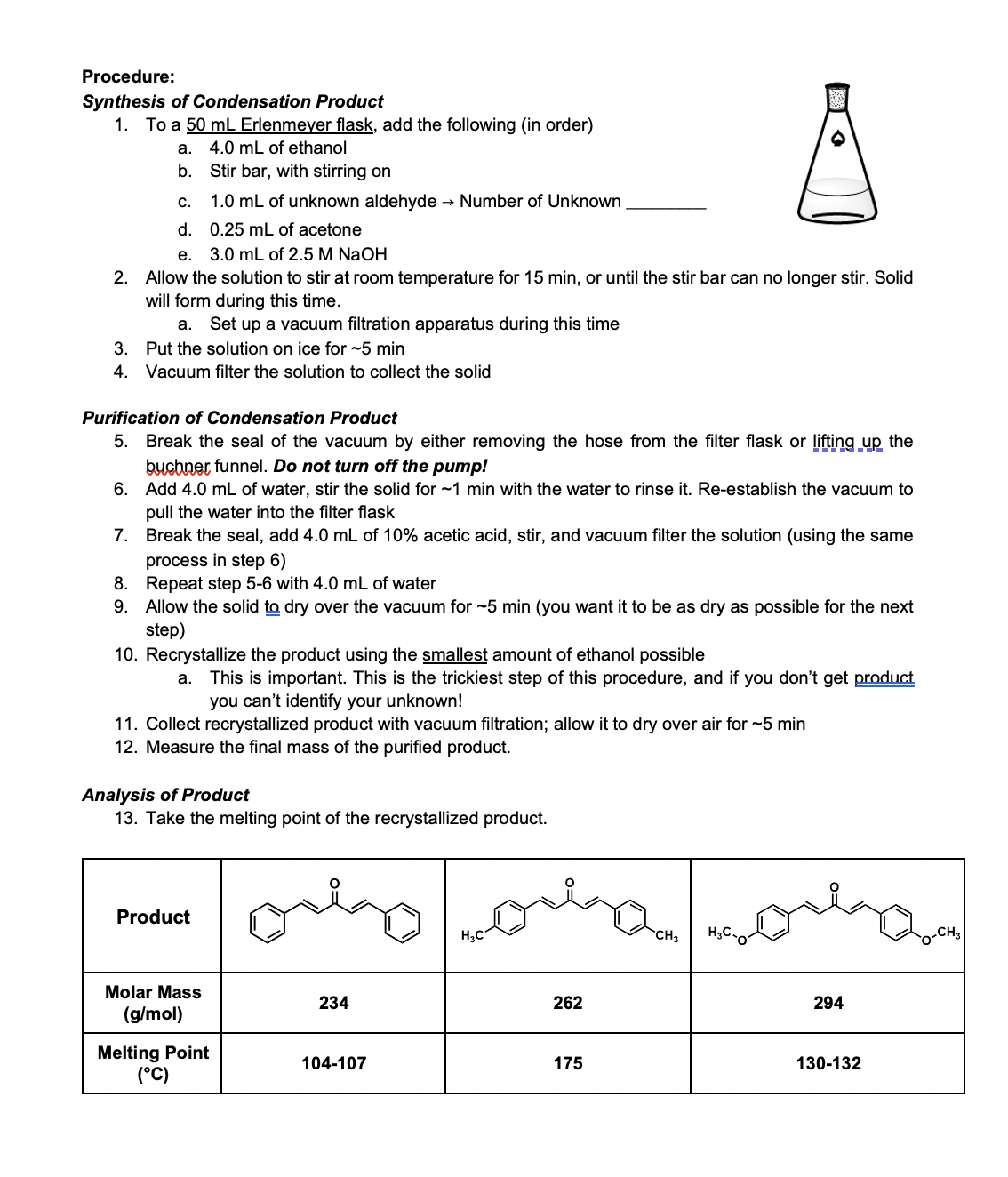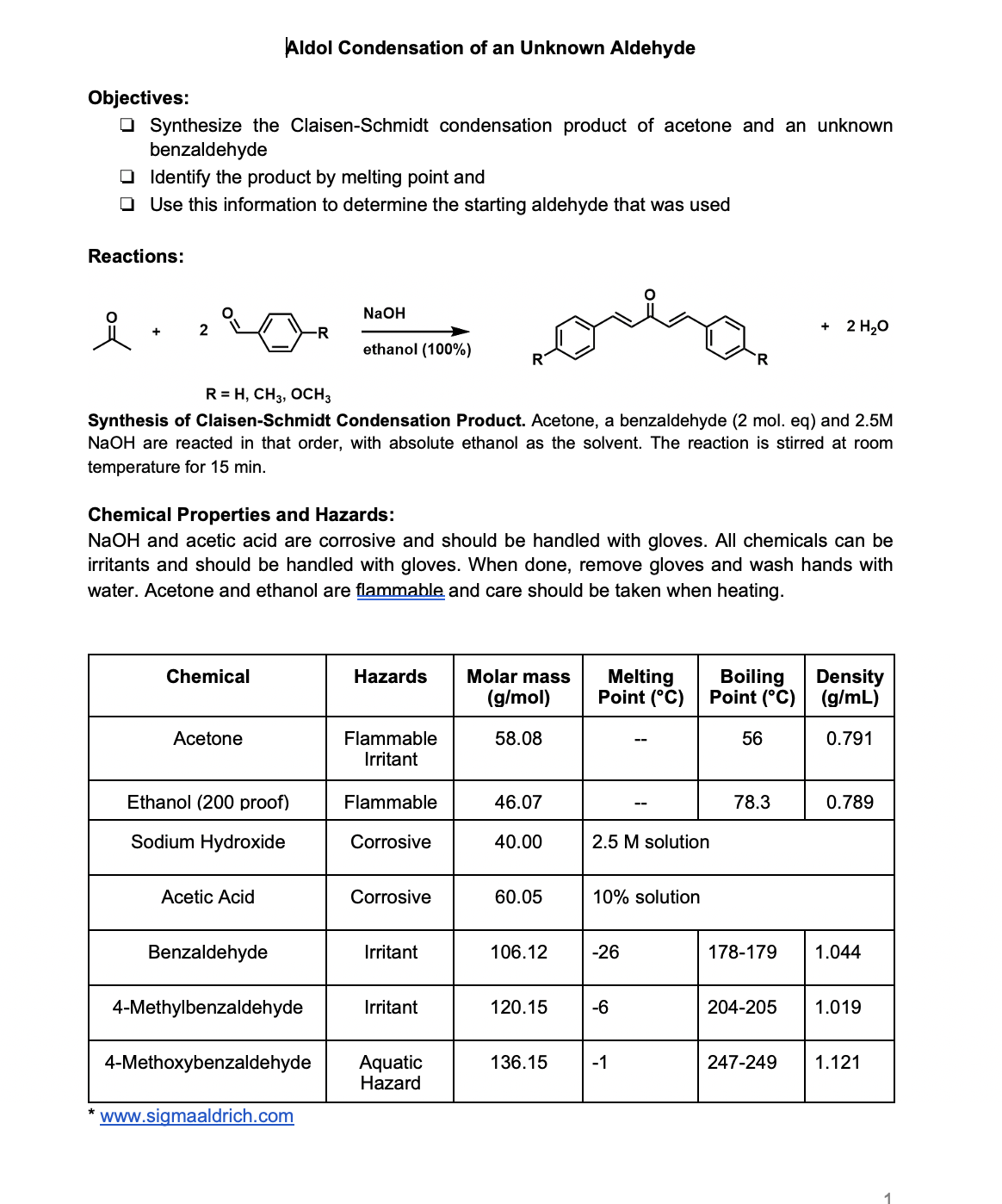Can you please answer and clearly show your work for all the parts to this question. Draw the three possible starting aldehydes you may use in this experiment. Calculate the moles in 1.0 mL for each. Write a general equation for converting from mL to mol. 1.0 mL = mol 1.0 mL = mol 1.0 mL = mol
Can you please answer and clearly show your work for all the parts to this question. Draw the three possible starting aldehydes you may use in this experiment. Calculate the moles in 1.0 mL for each. Write a general equation for converting from mL to mol. 1.0 mL = mol 1.0 mL = mol 1.0 mL = mol
Chapter9: Alkynes: An Introduction To Organic Synthesis
Section9.SE: Something Extra
Problem 46AP: A hydrocarbon of unknown structure has the formula C8H10. On catalytic hydrogenation over the...
Related questions
Question
Can you please answer and clearly show your work for all the parts to this question.
Draw the three possible starting
|
|
|
|
|
1.0 mL = mol |
1.0 mL = mol |
1.0 mL = mol |

Transcribed Image Text:Procedure:
Synthesis of Condensation Product
1. To a 50 mL Erlenmeyer flask, add the following (in order)
a. 4.0 mL of ethanol
b.
Stir bar, with stirring on
С.
1.0 mL of unknown aldehyde → Number of Unknown
d. 0.25 mL of acetone
е. 3.0 mL of 2.5 M NaOН
2. Allow the solution to stir at room temperature for 15 min, or until the stir bar can no longer stir. Solid
will form during this time.
a. Set up a vacuum filtration apparatus during this time
3. Put the solution on ice for -5 min
4. Vacuum filter the solution to collect the solid
Purification of Condensation Product
5. Break the seal of the vacuum by either removing the hose from the filter flask or lifting up the
bucbner funnel. Do not turn off the pump!
6. Add 4.0 mL of water, stir the solid for ~1 min with the water to rinse it. Re-establish the vacuum to
pull the water into the filter flask
7. Break the seal, add 4.0 mL of 10% acetic acid, stir, and vacuum filter the solution (using the same
process in step 6)
8. Repeat step 5-6 with 4.0 mL of water
9. Allow the solid to dry over the vacuum for ~5 min (you want it to be as dry as possible for the next
step)
10. Recrystallize the product using the smallest amount of ethanol possible
a. This is important. This is the trickiest step of this procedure, and if you don't get product
you can't identify your unknown!
11. Collect recrystallized product with vacuum filtration; allow it to dry over air for ~5 min
12. Measure the final mass of the purified product.
Analysis of Product
13. Take the melting point of the recrystallized product.
Product
H,C.
Molar Mass
234
262
294
(g/mol)
Melting Point
(°C)
104-107
175
130-132

Transcribed Image Text:Aldol Condensation of an Unknown Aldehyde
Objectives:
O Synthesize the Claisen-Schmidt condensation product of acetone and an unknown
benzaldehyde
O Identify the product by melting point and
O Use this information to determine the starting aldehyde that was used
Reactions:
NaOH
2
-R
2 Hо
ethanol (100%)
R.
R = H, CH3, OCH3
Synthesis of Claisen-Schmidt Condensation Product. Acetone, a benzaldehyde (2 mol. eq) and 2.5M
NaOH are reacted in that order, with absolute ethanol as the solvent. The reaction is stirred at room
temperature for 15 min.
Chemical Properties and Hazards:
NaOH and acetic acid are corrosive and should be handled with gloves. All chemicals can be
irritants and should be handled with gloves. When done, remove gloves and wash hands with
water. Acetone and ethanol are flammable and care should be taken when heating.
Chemical
Hazards
Molar mass
Melting
Point (°C)
Boiling
Density
Point (°C) (g/mL)
(g/mol)
Acetone
Flammable
58.08
56
0.791
Irritant
Ethanol (200 proof)
Flammable
46.07
78.3
0.789
Sodium Hydroxide
Corrosive
40.00
2.5 M solution
Acetic Acid
Corrosive
60.05
10% solution
Benzaldehyde
Irritant
106.12
-26
178-179
1.044
4-Methylbenzaldehyde
Irritant
120.15
-6
204-205
1.019
Aquatic
Hazard
4-Methoxybenzaldehyde
136.15
-1
247-249
1.121
www.sigmaaldrich.com
Expert Solution
This question has been solved!
Explore an expertly crafted, step-by-step solution for a thorough understanding of key concepts.
This is a popular solution!
Trending now
This is a popular solution!
Step by step
Solved in 2 steps

Knowledge Booster
Learn more about
Need a deep-dive on the concept behind this application? Look no further. Learn more about this topic, chemistry and related others by exploring similar questions and additional content below.Recommended textbooks for you


Organic Chemistry: A Guided Inquiry
Chemistry
ISBN:
9780618974122
Author:
Andrei Straumanis
Publisher:
Cengage Learning



Organic Chemistry: A Guided Inquiry
Chemistry
ISBN:
9780618974122
Author:
Andrei Straumanis
Publisher:
Cengage Learning
